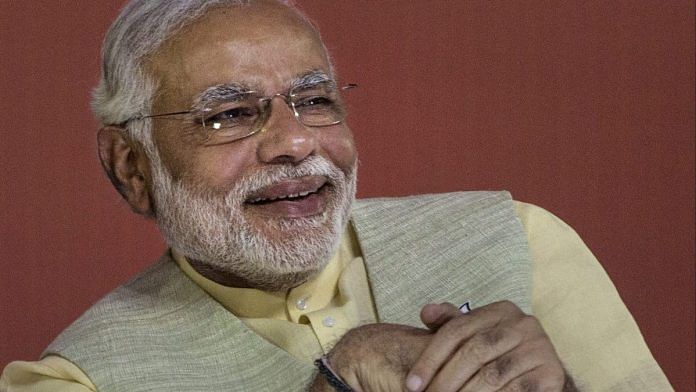Even if the Supreme Court strikes it down, the BJP would have already won political credit for being the party to think through this highly contentious idea.
From Imphal in Manipur to Silchar in Assam to Palamau in Jharkhand to Baripada in Odisha to Solapur in Maharashtra to Agra in Uttar Pradesh, all in the past week, Prime Minister Narendra Modi has notched up quite a few frequent flyer miles.
In between, he found time to meet Norwegian Prime Minister Erna Solberg, attend Observer Research Foundation’s Raisina Dialogue, speak to BJP karyakartas from Tamil Nadu over video-conference, tweet in favour of BJP MP Anurag Thakur who wore a ‘Namo Again’ hoodie to Parliament (“looking good @ianuragthakur!”) and sat down for an interview with the Humans of Bombay Facebook page.
But all this was clearly a side-dish to the main course this week, the passage of the Bill reserving 10 per cent for the economically weaker upper castes, in both Houses. All week as Parliament functioned, the PM was missing. Even when the Bill was introduced, he was absent. But he turned up for the vote in the Lok Sabha for an hour or so, and then left again.
The Bill tells you one thing about Narendra Modi, which is, never to write him off. Whether or not the Bill is later thrown out by the Supreme Court because it breaches the 50 per cent ceiling imposed by the court in 1992, is hardly the point; Modi showed that he always has an ace up his sleeve.
Also read: In headlines and in politics: How Modi govt brought the upper castes up
Ashen-faced Opposition leaders grit their teeth as they voted in favour of the Bill, realising they had no other option, that they had been trumped by the man they most disliked and hating every moment they did so.
The fact that Modi can still drive the entire Opposition to do his bidding even in the dying days of the 16th Lok Sabha is no mean achievement.
The way BJP leaders explain it, the new 10 per cent will not violate the Supreme Court’s ceiling on reservation because economic reservation is separate from the already existing ‘caste-based’ one. Even if the Supreme Court strikes it down, the BJP would have already won political credit for being the party to think through this highly contentious idea.
Certainly, the Congress cannot invoke the exact same Narasimha Rao notification, put forward by him as long back as the early 1990s, because it hardly considers Rao a Congress PM worth his name.
Moreover, the Supreme Court decreed at the time that Rao’s notification surpassed the ceiling; Modi’s BJP argues that the Constitution itself has been amended by more than a two-thirds majority both in the Lok Sabha and the Rajya Sabha earlier this week to create this additional slab and that the court has no right to strike it down. (Of course, the court may not listen.)
Also read: Can reservation help BJP get the upper caste vote in Lok Sabha elections?
Whatever. Young metrosexuals, 18 years and above and voting for the first time this summer will shrug their shoulders, even as the Opposition fulminates. Modi is clearly hoping younger Indians will buy into his argument.
Carefully, the PM is stitching together his electoral strategy, in the hope that the whole will become more than the sum of its parts. Ten per cent reservation for economically backwards + Modicare on which Rs 700 crore has been spent on 70 lakh beneficiaries in the past 100 days + wooing Dalits with public adulation of Ambedkar + a likely package to alleviate farm distress amounting to a few lakh crores.
Whether or not voters buy this remains to be seen. The impact of the November 2016 demonetisation exercise on the economy, two years later, is staggering. Unemployment is at a four-year high according to the Labour Bureau.
And according to Mahesh Vyas of the Centre for Monitoring Indian Economy, a survey of 1.72 lakh households suggests demonetisation had a traumatic effect on livelihoods. As many as 12.7 million lost their jobs in the first month immediately following demonetisation in November 2016, which came down to 3.5 million in subsequent months.
Also read: Modi’s quota bill is just a band-aid solution and doesn’t promise more jobs
Considering India needs to generate 20 million jobs every year, a strange mood of both ennui and anger seems to be enveloping the country. People are buckling down, hunching inwards, tightening their belts—as if to say, the good times when wealth was being created were hardly expected to last.
Modi is certainly hoping he will be able to reverse this message by the time the poll season begins in earnest. This week was a good demonstration of that intent.




On the contrary, it’s a big GAMBLE by Mr Modi. The so called “suvarna” vote may or may not come back to them, but the REAL poor upper caste will see in this move the “true colors” of the BJP and feel decisively alienated from it.
Someone who’s earning a taxable income of up to 8 lakhs already has a certain amount of self confidence in himself, and wherewithal to go get what he wants. A reservation of 10% won’t impress him. But a poor brahmin or an otherwise upper caste who’s living in poverty will hate Mr Modi for “insulting” him — for pitting him against the “rich” man. Because a person who’s earning nearly a lakh of rupees every month is certainly not poor like himself!
On the other hand, with this kind of income bracket, nearly ALL of India will qualify to be eligible, so what’s the big deal about it — all will think. Earlier too they were competing with all of them, so where exactly is the “reservation” for the really poor upper caste people?